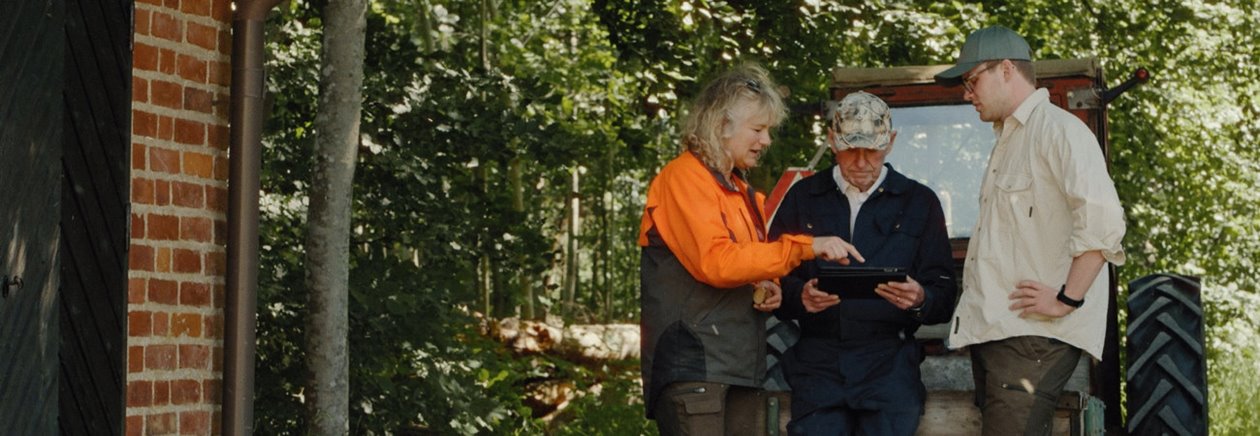Members only

Södra belongs to more than 52,000 forest-owner members who own every second forest estate in Småland. But how much do we know about them and the forests they manage?
Who is a typical member?
Many of our members are sixth or seventh-generation (or more) foresters who regard themselves as custodians of their estates, nurturing them to pass on to the next generation through sustainable forest management. Some are full-time farmers, but others have separate careers, including with Södra, and use their spare time to look after their holdings. The membership includes many small-scale forest farmers with a range of ideas and targets, contributing to highly-varied and diverse forest characteristics. Every Södra member has their own forest management plan. Many, but not all, live on their estates.
How do members know how much to harvest?
Every family farm estate is different, but an average member estate will only harvest about two hectares per year.
Members know that forests are a resource that should be used, but not overused, which is why they manage and harvest their forests sustainably. We base the harvest rates we advise on the recommendations of the Swedish Forest Agency and the Swedish University of Agricultural Sciences. To increase conservation considerations, all harvesting operations are reviewed and rated using a Green Balance Sheet.
So do they manage to balance economics with biodiversity?
In short, yes. Our members’ forestry methods are devised to ensure biodiversity. In the last 20 years, more trees have been left to grow old, the proportion of hardwoods in coniferous forest has increased and more dead wood has been left undisturbed. These initiatives are important for many species and contribute to a more varied forest landscape. Also, more forest is set aside voluntarily for nature conservation. We have set a target for our members to carry out nature conservation measures on 3,000 hectares annually by 2025.
How soon can members harvest the trees they have planted?
A mature tree is typically harvested when it is 60-70 years old, so most members will harvest the planting of previous generations – and will always plant three saplings for every tree felled, for the next generation of the forest’s custodians. They will only extract wood from their own planting when thinnings are taken to give the remaining trees the space, nutrients and light they need to grow. It’s the thinnings and top branches that are used for pulp, while the lower part of the mature tree, the highest value part, goes to the sawmills. Every part of the tree is used in the best possible way, so apart from timber products and pulp, our members’ forests also yield green energy and bioproducts such as biomethanol, tall oil and turpentine.
So what about monocultures?
Only 20 percent of the forests managed by Södra's family forest owners have a single tree species dominating by more than 70 percent. Most of the forests consist of mixed species. We want to make it easier for forest owners to create greater diversity by developing methods to create mixed forests of pine and spruce, but also by cultivating more hardwood seedlings.
Foresters strive to plant the right tree species in the right location, mimicking nature and ensuring optimal growth conditions. Pine now represents around 36 percent of our plant sales in Southern Sweden, which is approaching the natural proportion.
How many members hold certifications?
A key tool for sustainable forestry is certification, which is why about 70 percent of our members hold FSC® and/or PEFC certification. That represents 1.8 million hectares of forest. Members are offered incentives to become certified and there are added incentives to set aside more conservation area than these stringent systems require. Many members do this voluntarily, because they understand that a healthy, growing forest is essential for all our futures.
Wouldn’t “inaction” be the most climate-positive action members could make? Shouldn’t they just leave their forests untouched?
The forest is a carbon store but one that is vulnerable to storms, fire or insect infestation, all of which we have experienced in our part of Sweden. It is therefore a risky climate strategy to just leave the forest standing and enable the continued use of fossil resources instead of using the forest raw material to reduce our dependence on fossil fuels.
Show all content for topic
Subjects: Pulp
